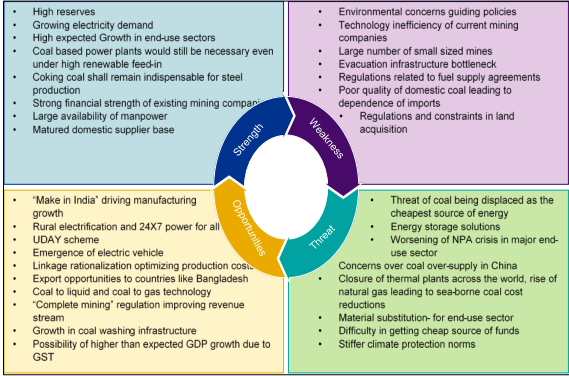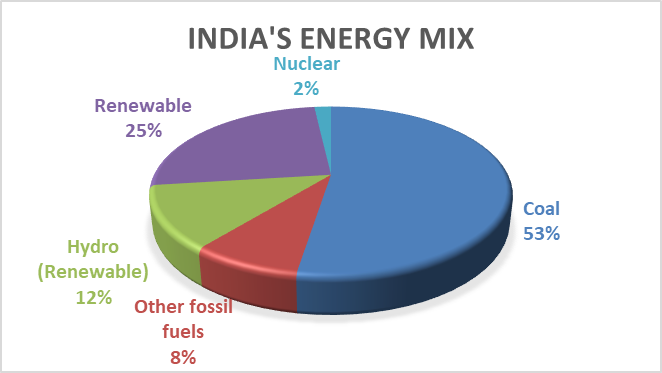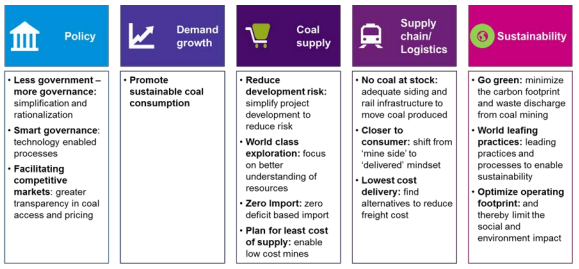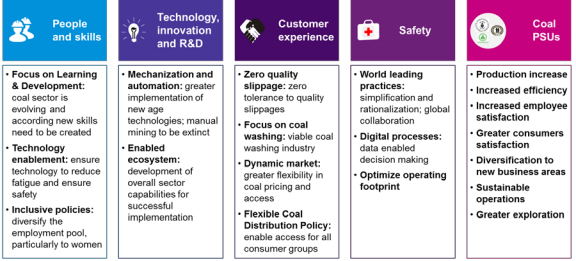Coal Mining in India
2022 OCT 27
Mains >
Science and Technology > Energy > Resource geography

IN NEWS:
- On average, India’s coal mines use only two-thirds of the capacity with some large ones using only 1%, says an analysis by Global Energy Monitor (GEM), a firm that tracks utilisation of the fuel-source internationally.
INDIAN COAL:
- With a cumulative total of nearly 319.02 billion tonnes, India has the fourth largest reserve of coal in the world.
- The Coal resources of India are available in older Gondwana Formations of peninsular India and younger Tertiary formations of north-eastern region. Gondwana coal accounts for 99 % of India’s coal production.
- Types of coal found in India:
- Anthracite: It is the highest grade of coal, containing 80-95 % carbon. It is found in smaller quantity in regions of Jammu and Kashmir.
- Bituminous: It is a medium grade of coal having 60 to 80% of carbon content. It is found in Jharkhand, Odisha, West Bengal, Chhattisgarh, and Madhya Pradesh.
- Lignite: It is the lowest grade coal with 40 to 55% carbon content. It is found in the regions of Rajasthan, Tamil Nadu, and Jammu & Kashmir.
Supply:
- India is the second largest producer and consumer of coal after China. India produced 729 million tonnes coal in 2019-20 and 716.01 MT during 2020-21.
- Top 5 States in terms of total coal reserves in India are Jharkhand, Odisha, Chhattisgarh, West Bengal and Madhya Pradesh.

Demand:
- Coal accounts for 52.6% of the country's energy mix.

ISSUES IN COAL SECTOR:
I. PRODUCTION SIDE:
- Import dependency:
- India lacks sufficient reserves of good quality coking coal and boilers of many thermal power plants are designed to run only on imported coal. Hence, there is heavy dependence on imports.
- Eg: The country imported 209 million tonnes (MT) of coal in FY21-22.
- Continuing Monopoly:
- Despite encouraging private participation in coal mining, Coal India limited (CIL) continues to have a monopoly. However, Coal India has not been able to meet the increasing demand for coal.
- The all-India production of coal during 2021-22 were 778.19 MT, of which nearly 80 percent (622 MT) was produced by CIL.
- Lack of adequate technology:
- Technology adoption in underground mining remanis limited. 87% of the underground coal mines of CIL are either semi-mechanised or non-mechanised (manual).
- Lack of competitiveness:
- Because of strict regulations and lack of mechanization, Indian coal plants have higher operation and maintenance costs. Even in mechanized coal fields, operating performance is lower than global peers.
- Eg: Similar class of shovels in international mines are operated 40–50 per cent more hours annually than they are at CIL.
- Safety concerns:
- Accidents and loss of human life due to mine collapse and flooding is a recurring issue in Indian coal mines. There are also issues of child labour and exploitation of workers in mines.
|
Rat hole mining and child labour:
The mines of Meghalaya are places where children work, live and die in some of the most inhuman work environments. A rat-hole mines comprises a deep vertical shaft with narrow horizontal tunnels, two to four feet in dimension, dug on its sides. Miners, often children, go into these horizontal tunnels to take out coal.
National Green Tribunal banned 'rat hole' coal mines in 2014, labelling them unscientific, and unsafe for workers. However, many mines continue to operate illegally.
Workers involved in rat-hole mining, the majority of whom are children, are generally lured into this work due to the wages offered and the poor living conditions. Most of the children are either migrants or trafficked from neighbouring countries of Nepal and Bangladesh by agents.
|
II. DISTRIBUTION:
- Logistical challenges:
- 80% of coal resources in India are concentrated in four states. This necessitates better logistics for bulk transportation over long distances. However, environmental concerns over road transport, cross subsidy and shortage of sufficient rail rakes remain major impediments.
- Tax structure and transportation cost:
- Taxes, duties and levies account for up to 25% and freight accounts for up to 34% of the overall coal cost, undermining the competitiveness of domestic coal.
III. CONSUMPTION SIDE:
- NPA crisis in power sector:
- Steel and power sector are two major consumers of coal. But these sectors are the most affected by the NPA crisis.
- Global aversion to coal:
- There is shrinkage in global coal consumption, due to threat of climate change and also due to global economic slowdown. India’s commitment under the Paris agreement and Panchamrit at COP 26 hinders the promotion of coal.
IV. OTHER ISSUES:
- Competition from renewables:
- With increasing efficiency and declining cost of production, renewable sources such as solar and wind are emerging as reliable alternatives to coal energy in India.
- Judicial interventions:
- In 2014, the Supreme Court had cancelled 214 coal blocks that were allotted since 1993. This was a major setback for the mining industry in general and coal sector in particular.
- Land acquisition and eviction:
- Involvement of multiple agencies, environmental considerations and questions over eviction of local population results in delays in getting requisite clearances for mining operations, leading to cost overrun
- Corruption:
- Recurring mining scams are a major political issue in India. The nexus between politicians and mining mafia has resulted in numerous Illegal mines sprouting across the country.
- Displacement and destruction:
- As per the GEM report, coal mines under development threaten to displace at least 165 villages and affect 87,630 families, of which 41,508 families live in areas where the predominant population is tribal communities.
- Coal mines under development also threaten 22,686 hectares (ha) of agricultural land and 19,297 ha of forest, and will consume at least 168,041 kilolitres of water per day.
- Threat from left wing extremists:
- The major coal belts continue to be hotspots of Naxalism in India. This affects ease of doing business in the country and dissuades private players in the sector.
- Ecologically bad practices:
- Recently Government did away with the regulation requiring power plants to use “washed” coal, by terming it an unnecessary cost on coal users. This increases the environmental impact from using coal.
|
Coal washing in India:
Coal washing is a process that is undertaken in a coal washery where coal is refined or cleaned of impurities using water, mechanical techniques. These technologies are meant to allow the conservation and optimal use of coal reserves by improving the quality and efficiency of low grade, high ash Indian coal.
In 2014, as part of its climate change commitments, India made coal washing mandatory for supply to all thermal units beyond 500 kms from the coal mine. This was done away in 2020.
|
EFFORTS TO REFORM COAL SECTOR:
- Coal Mines (Special Provisions) Act, 2015:
- The act paved the way for greater private participation in coal mining in India.
- It amended the coal mines (Nationalisation) Act, 1973 and the MMDR Act, 1957 and introduced three categories of coal mines.
- It provided for allocation of coal mines to successful bidders and allottees through a transparent bidding process.
- Mines and Minerals (Development and Regulation) Amendment (MMRDA) Act, 2021
- It provides for removal of restriction on end-use of minerals, transfer of statutory clearances, allocation of mines with expired leases and sale of minerals by captive mines, among others.
- The Act will promote ease of doing business in mining and attract investment into the sector.
- Mines and Minerals (Development and Regulation) Act, 2015
- Initially established in 1957, it regulates the mining sector and specifies the requirement for obtaining and granting mining leases for mining operations.
- The Act was amended in 2015 to bring several reforms in the mineral sector, notably:
- Mandating auction of mineral concessions to improve transparency
- Establishing District Mineral Foundation and National Mineral Exploration Trust
- Stringent penalty for illegal mining
- The Act was further amended in 2016 and 2020 to allow transfer of leases for non-auctioned captive mines and to deal with the emergent issue of expiry of leases.
- The Mineral Laws (Amendment) Act, 2020:
- Removal of restriction on end-use of coal: Previously, companies that acquiring coal mines through auctions could use the coal produced only for specified end-uses such as power generation and steel production. The Act removes this restriction.
- Eligibility for auction of coal and lignite blocks: The Act clarifies that the companies need not possess any prior coal mining experience in India in order to participate in the auction of coal and lignite blocks.
- Composite license for prospecting and mining: The Act adds a new type of license, called prospecting license-cum-mining lease. This eliminates the need of multiple licenses for prospecting and mining of coal and lignite
- Prior approval from the central government: Act provides that the state governments no longer require prior approval of the central government for granting licenses for coal and lignite, in certain cases.
- Advance action for auction: The Act provides that state governments can take advance action for auction of a mining lease before its expiry.
- Transfer of statutory clearances to new bidders
- UTTAM (Unlocking Transparency by Third Party Assessment of Mined Coal) Application:
- In 2018, Ministry of Coal has launched UTTAM app to ensure transparency and efficiency in coal quality monitoring process and bring coal governance closer to people.
- SHAKTI (Scheme to Harness and Allocate Koyla (coal) Transparently in India):
- It aims to centralise the process of allocating coal to thermal power plants.
- Under this, coal linkage would be first given to DISCOMS and after that the government would assign linkage to state or central power generation companies through allocation or auctions.
- Online Coal Clearances System:
- Ministry of Coal has developed Online Coal Clearances System to provide a single window access to its investors to submit online applications for all the permissions / clearances and approvals granted by Ministry of Coal.
- Coal Allocation Monitoring System (CAMS):
- A new web portal for Small and Medium Sector consumers of Coal India Limited (CIL) for ease of business and to bring transparency in distribution of coal to SME sectors.
- Coal Mitra Web Portal:
- It has been designed to bring about flexibility in Utilization of Domestic Coal by transferring the reserves to more cost-efficient State/Centre owned or Private sector generating stations, leading to lower generation costs and ultimately lesser cost of electricity for the consumers
- Alternative Disputes Resolution Mechanism (ADR):
- Ministry of Coal has constituted an Alternative Disputes Resolution Mechanism (ADRM) forum to resolve the disputes between State power utilities and CIL and its subsidiaries.
- Coal Mines Provident Fund Organisation (CMPF):
- It serves as the official pension fund of Coal miners and is financed by coal producers on a per-tonne basis.
WAY FORWARD:


The challenge for policy makers is to identify the route which maintains a fine balance between meeting the demand–supply scenario while maintaining a sustainable developmental trajectory. Some measures in this regard can include:
- Coal Regulator:
- Establish a coal regulator with clear mandate to enable competitive market structure in coal sector in India.
- Improve competitiveness of domestic coal:
- Establish a technical committee for rationalization, standardization of all approvals (Central, State level) for opening of coal mines in India.
- Greater focus on cost competitiveness of domestic coal must be ensured in order to retain their competitiveness as compared to imported one.
- Improve safety performance:
- A dedicated effort is to be made to ensure achievement of the goal of zero fatalities and injuries. The government must ensure that the welfare of coal miners in private mining is at par with the status of workers in CIL.
- Coal trading platform:
- Establish an online platform to facilitate coal trading/transactions in India including spot/forward auction.
- Collaborate to minimize environmental impact:
- Create a joint forum of power developers and coal mining companies to undertake investment in R&D for Carbon Capture and Sequestration (CCS) and coal washing technologies in India.
- Technology in exploration:
- Increase adoption of remote sensing, geophysical and geochemical logging, 2D and 3D seismic survey in the exploration of coal reserves.
- Improve rail infrastructure:
- Emphasis should be given on improving the carrying capacity of railway lines availability of rakes and review of cross subsidy system.
- Coal beneficiation:
- As India’s coal is high in ash content, coal beneficiation should be done to reduce the ash content and improve its grade.
- Centre of Excellence:
- Create a CoE focused on mechanization and automation and digital technologies in mining in collaboration with a leading global organization
PRACTICE QUESTION:
Q. ‘Despite the growth of renewable energy, coal has an indispensable place in India’s energy mix.’ In this regard, discuss the issues faced by coal mining sector in India. What measures have the government taken to promote the sector?
Q. “Inspite of adverse environmental impact, coal mining is still inevitable for development”. Discuss. (150 words, 10 marks) (GS 1, UPSC 2017)




